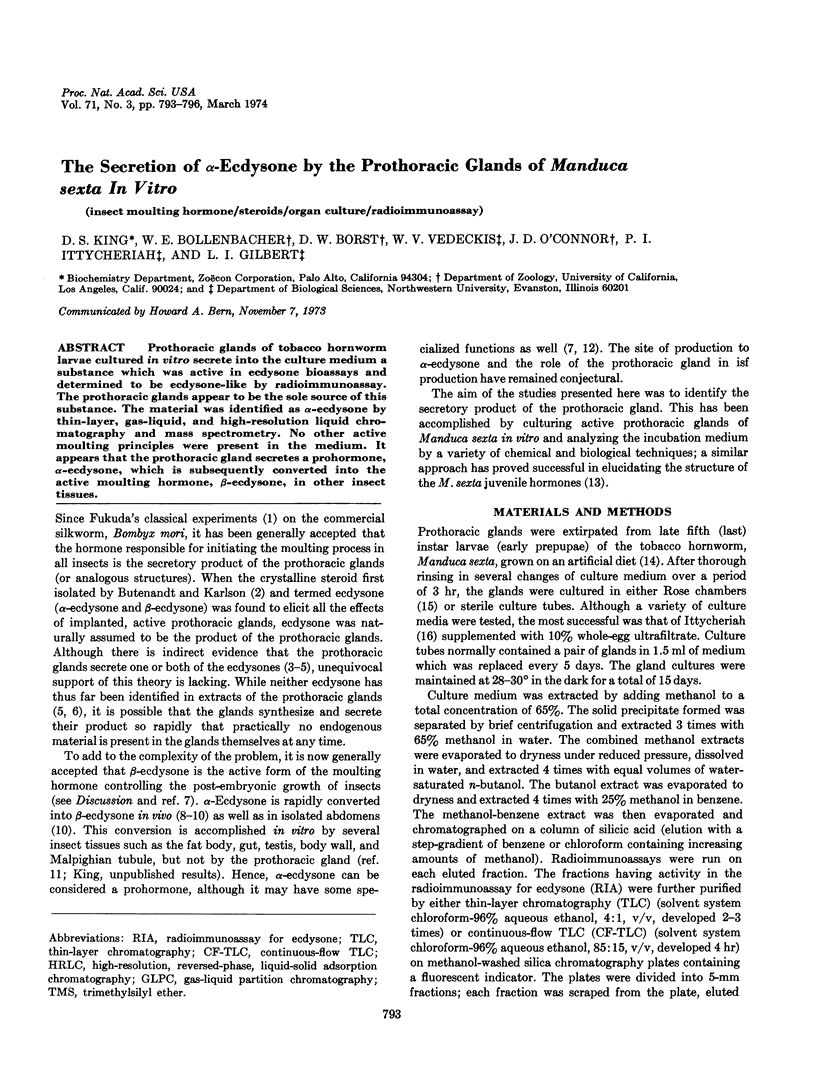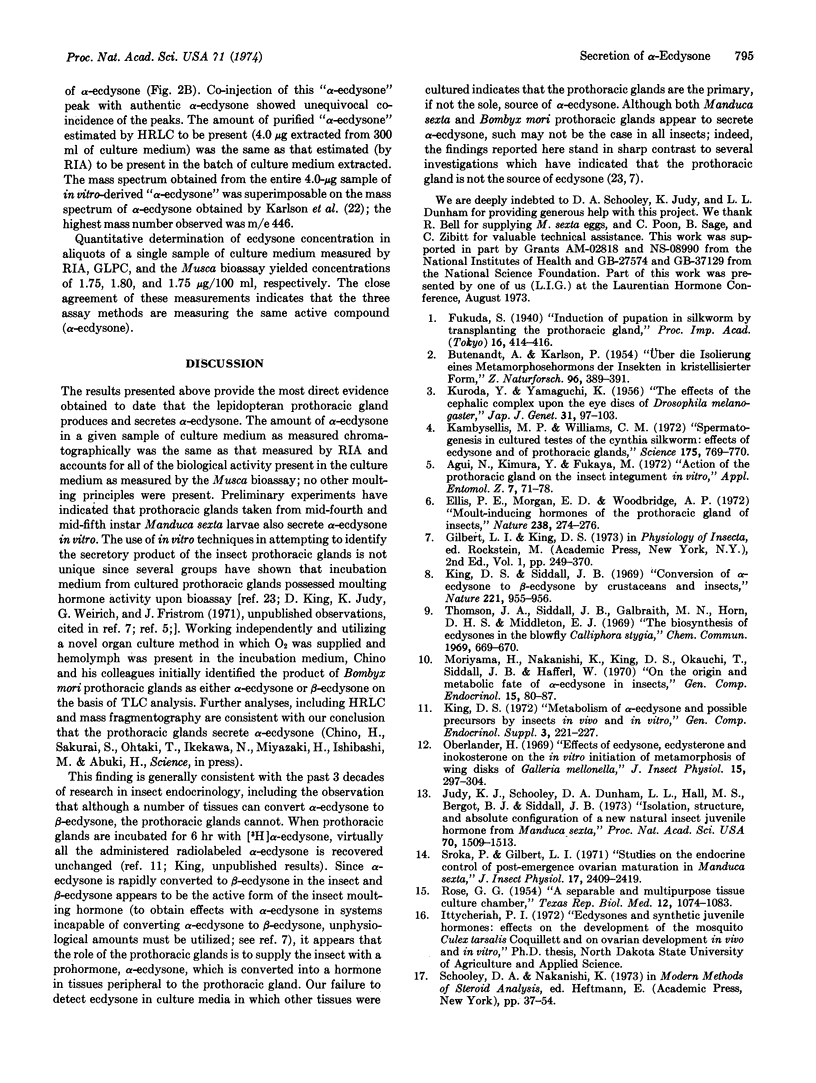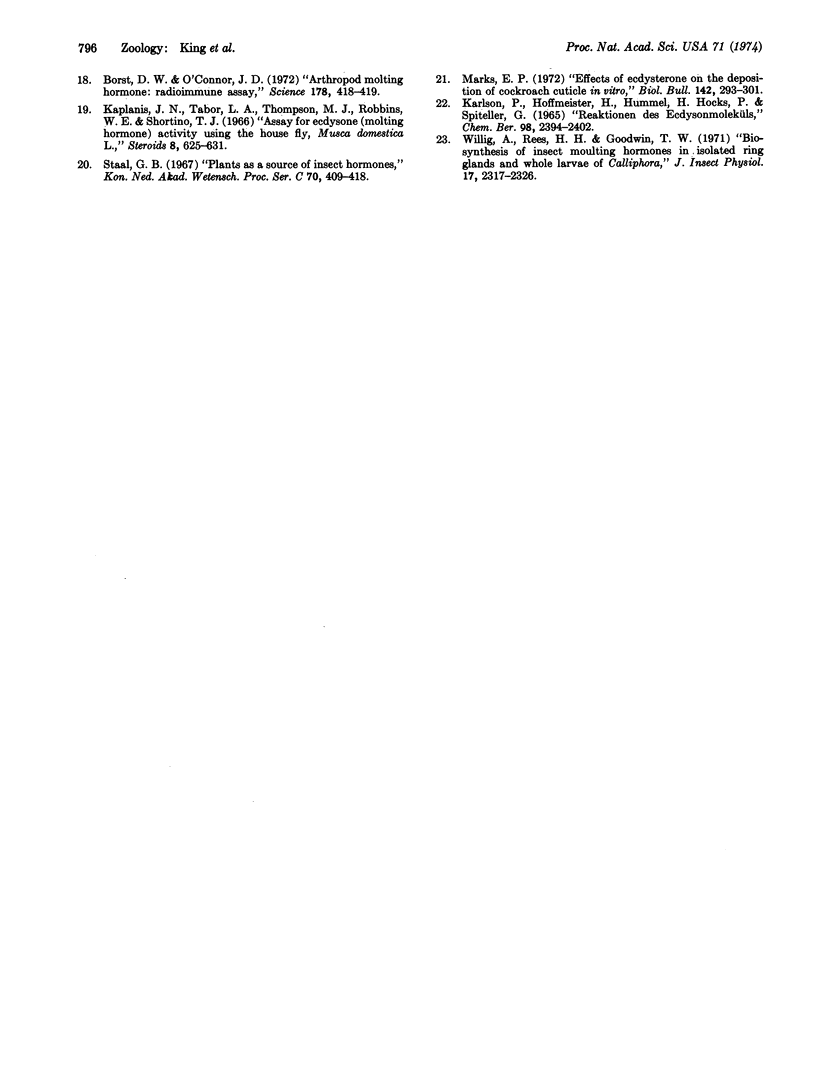Abstract
Prothoracic glands of tobacco hornworm larvae cultured in vitro secrete into the culture medium a substance which was active in ecdysone bioassays and determined to be ecdysone-like by radioimmunoassay. The prothoracic glands appear to be the sole source of this substance. The material was identified as α-ecdysone by thin-layer, gas-liquid, and high-resolution liquid chromatography and mass spectrometry. No other active moulting principles were present in the medium. It appears that the prothoracic gland secretes a prohormone, α-ecdysone, which is subsequently converted into the active moulting hormone, β-ecdysone, in other insect tissues.
Keywords: insect moulting hormone, steroids, organ culture, radioimmunoassay
Full text
PDF



Selected References
These references are in PubMed. This may not be the complete list of references from this article.
- Borst D. W., O'connor J. D. Arthropod molting hormone: radioimmune assay. Science. 1972 Oct 27;178(4059):418–419. doi: 10.1126/science.178.4059.418. [DOI] [PubMed] [Google Scholar]
- Judy K. J., Schooley D. A., Dunham L. L., Hall M. S., Bergot B. J., Siddall J. B. Isolation, Structure, and Absolute Configuration of a New Natural Insect Juvenile Hormone from Manduca sexta. Proc Natl Acad Sci U S A. 1973 May;70(5):1509–1513. doi: 10.1073/pnas.70.5.1509. [DOI] [PMC free article] [PubMed] [Google Scholar]
- Kambysellis M. P., Williams C. M. Spermatogenesis in cultured testes of the cynthia silkworm: effects of ecdysone and of prothoracic glands. Science. 1972 Feb 18;175(4023):769–770. doi: 10.1126/science.175.4023.769. [DOI] [PubMed] [Google Scholar]
- Kaplanis J. N., Tabor L. A., Thompson M. J., Robbins W. E., Shortino T. J. Assay for ecdyse (molting hormone) activity using the house fly, Musca domestica L. Steroids. 1966 Nov;8(5):625–631. doi: 10.1016/0039-128x(66)90003-1. [DOI] [PubMed] [Google Scholar]
- Karlson P., Hoffmeister H., Hummel H., Hocks P., Spiteller G. Zur Chemie des Ecdysons. VI. Reaktionen des Ecdysonmoleküls. Chem Ber. 1965 Jul;98(7):2394–2402. doi: 10.1002/cber.19650980743. [DOI] [PubMed] [Google Scholar]
- King D. S., Siddall J. B. Conversion of alpha ecdysone to beta ecdysone by crustaceans and insects. Nature. 1969 Mar 8;221(5184):955–956. doi: 10.1038/221955a0. [DOI] [PubMed] [Google Scholar]
- Marks E. P. Effects of ecdysterone on the deposition of cockroach cuticle in vitro. Biol Bull. 1972 Apr;142(2):293–301. doi: 10.2307/1540232. [DOI] [PubMed] [Google Scholar]
- Moriyama H., Nakanishi K., King D. S., Okauchi T., Siddall J. B., Hafferl W. On the origin and metabolic fate of alpha-ecdysone in insects. Gen Comp Endocrinol. 1970 Aug;15(1):80–87. doi: 10.1016/0016-6480(70)90099-7. [DOI] [PubMed] [Google Scholar]
- Oberlander H. Effects of ecdysone, ecdysterone, and inokosterone on the in vitro initiation of metamorphosis of wing disks of Galleria mellonella. J Insect Physiol. 1969 Feb;15(2):297–304. doi: 10.1016/0022-1910(69)90276-5. [DOI] [PubMed] [Google Scholar]
- ROSE G. A separable and multipurpose tissue culture chamber. Tex Rep Biol Med. 1954;12(4):1074–1083. [PubMed] [Google Scholar]
- Sroka P., Gilbert L. I. Studies on the endocrine control of postemergence ovarian maturation in Manduca sexta. J Insect Physiol. 1971 Dec;17(12):2409–2434. doi: 10.1016/0022-1910(71)90088-6. [DOI] [PubMed] [Google Scholar]


